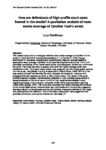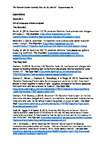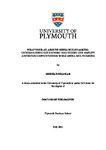How are defendants of high-profile court cases framed in the media? A qualitative analysis of news media coverage of Caroline Flack’s arrest
| dc.contributor.author | Matthews, L. | |
| dc.date.accessioned | 2021-12-24T18:09:33Z | |
| dc.date.available | 2021-12-24T18:09:33Z | |
| dc.date.issued | 2021 | |
| dc.identifier.citation |
Matthews, L. (2021) 'How Are Defendants of High-Profile Court Cases Framed in the Media? A Qualitative Analysis of News Media Coverage of Caroline Flack’s Arrest', The Plymouth Student Scientist, 14(2), pp. 548-570. | en_US |
| dc.identifier.uri | http://hdl.handle.net/10026.1/18515 | |
| dc.description.abstract |
This present study aims to investigate whether news media coverage on Caroline Flack’s arrest, in December 2019, showed characteristics of ‘Trial by Media’ (TBM) through identification of one-sided, unbalanced or predominantly negative, sensationalised or speculative news coverage. Caroline Flack’s case has importance due to her ‘media trial’ potentially contributing to her mental health issues, and subsequent suicide two months after her arrest. This study also aims to assess how much this media coverage could have contributed to this. Forty news media articles were analysed from the 18-day period, starting from her arrest, using Media Framing Analysis (MFA; Giles & Shaw, 2009). MFA is a five-step analytic process that identifies the story, analyses the characters, narrative form, language (thematic analysis) and links to wider social context. The results of this study provide evidence to support Caroline being subjected to TBM, showing characteristics of sensationalisation of the crime, use of ‘evidence’ that would be inadmissible in court, negative portrayals of her character, one-sided (Vitelli, 2018) and speculative reporting (Greer & McLaughlin, 2012). This study also concluded that media coverage did contribute to her mental health issues, however there was much evidence in the data that suggested she had a history of mental health and that the Criminal Prosecution Service (CPS), media and public ignored this evidence. Links to the wider social context also suggested other potential contributors, such as her involvement with realty TV. | en_US |
| dc.language.iso | en | en_US |
| dc.publisher | University of Plymouth | en_US |
| dc.rights | Attribution 3.0 United States | * |
| dc.rights.uri | http://creativecommons.org/licenses/by/3.0/us/ | * |
| dc.subject | News Media | en_US |
| dc.subject | Framing | en_US |
| dc.subject | Caroline Fla | en_US |
| dc.subject | Trial by Media | en_US |
| dc.subject | Media Framing Analysis | en_US |
| dc.subject | Reality TV | en_US |
| dc.subject | Mental health | en_US |
| dc.subject | Criminal Prosecution Service | en_US |
| dc.title | How are defendants of high-profile court cases framed in the media? A qualitative analysis of news media coverage of Caroline Flack’s arrest | en_US |
| dc.type | Article | en_US |
| plymouth.issue | 2 | |
| plymouth.volume | 14 | |
| plymouth.journal | The Plymouth Student Scientist |





